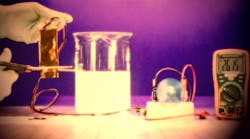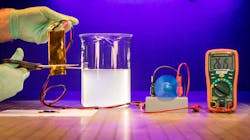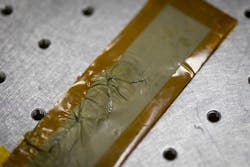A cross-functional team of scientists from John Hopkins University Applied Physics Laboratory (APL), the University of Maryland, and the Army Research Laboratory (ARL) have invented a flexible, gel-based lithium-ion (Li-ion) battery that continues to power load even after being cut in half, submerged in water, and shot with an air cannon. The breakthrough technology is novel in its ability to withstand abuse and may redefine how the world thinks about power.
A Brief History
We may live in a digital world, but the mighty force behind all our electronics is still that unsung hero: the battery. The very first battery was built in 1800 by Alessando Volta (after whom the Volt is also named). Called the Voltaic Pile, the battery was a pile of alternating copper and zinc plates with layers of moistened with electrolytes. Though highly impractical for commercial use, it was the foundation for the hundreds of energy and fuel storage systems we’ve seen since—including one of the most popular rechargeable batteries today: lithium-ion.
The flexible battery is cut and continues to power load. (Credit: John Hopkins APL)
Lithium-Ion
Research on lithium-ion battery technology began in 1912. In 1970, the first Li-ion battery hit the market, and the technology has rapidly increased in popularity since. Li-ion production capacity was 29 gigawatt-hours in 2016. The demand for mobile power solutions for consumer electronics only continues to rise, and to date, there has not been a better rechargeable power solution than Li-ion. Li-ion technology, however, is not without issues.
The Problem with Existing Li-ion Batteries
Lithium-ion technology poses a serious problem: Li-ion batteries can explode and burst into flames. Li-ion batteries are comprised of two electrodes (an anode and a cathode), separated by a layer of electrolytes which allow electrons to flow from one electrode to the other. The electrolyte used in Li-ion batteries, however, is highly flammable and bursts into flames when punctured or if conditions of extremely high heat are present (say, the kind of high heat present in a flammable Samsung Galaxy smartphone).
The new gel-based battery invented by APL researchers, however, may have solved the known issues with using Li-ion technology.
The GPE-based battery continues to power load after being shot with an air cannon. (Credit: John Hopkins APL)
The Near-Indestructible Li-ion Battery
The flexible battery developed by the team of scientists at APL, UMD, and ARL is based on a novel electrolyte that APL and UMD researchers discovered in 2015, called “water-in-salt.” The team embedded the water-in-salt electrolyte in a polyvinyl alcohol (PVA) polymer matrix. The result is a gel polymer electrolyte (GPE) that is more stable than a liquid, but also boasts flexibility and the high-energy capabilities of its commercial counterparts.
The flexible battery features an energy density of 141 Wh/kg and a power density of 20 600 W/kg, making it both powerful and potentially useful for applications exposed to extreme conditions.
In an experiment, the research team built a prototype using the GPE substrate, enclosed between pieces of electronically insulating heat-resistant tape. The team used the battery to power a hefty motor. Then, the researchers cut the battery, submerged it in a tank of synthetic salt water, and shot it with an air cannon. The battery continued to power load despite the extreme, abusive conditions.
Unlike Any Battery on the Market
The flexible GPE-based battery seems to be about 4 inches high x 1 inch wide. It looks to be no thicker than a stick or two of gum, yet it features extremely high energy and power densities for its size. The battery is unprecedented by anything else on the market.
Though similar in output to traditional Li-ion batteries, the versatility of the GPE-based technology is unparalleled by both Li-ion technology and other emerging battery technologies like Al-O batteries, solid-state batteries, and micro-batteries. These all promise to function better under extreme conditions than Li-ion technologies, but cannot offer the same rechargeable capabilities or power output as Li-ion.
Future Applications
The research team announced it plans to continue to work together toward the commercialization of a military application. In a press release, Jeffrey P. Maranchi—Signature, Energy, and Materials Science Program Manager at APL—said the team is not far from having a design viable for use in the extreme conditions expected in military applications. Maranchi said the feedback the team has gotten so far is promising and they are close to field trials.
If a GPE-based battery can perform under the extreme conditions of the military, it should certainly be able to withstand the everyday power demands and use cases of consumer electronics. Further, if the technology can meet the same specs as existing Li-ion technology without exploding under pressure, it will only be a matter of time before GPE structures make it into our cell phones.
While this does not solve the problem of battery size for wearable applications, it’s certainly a shift in the right direction.




